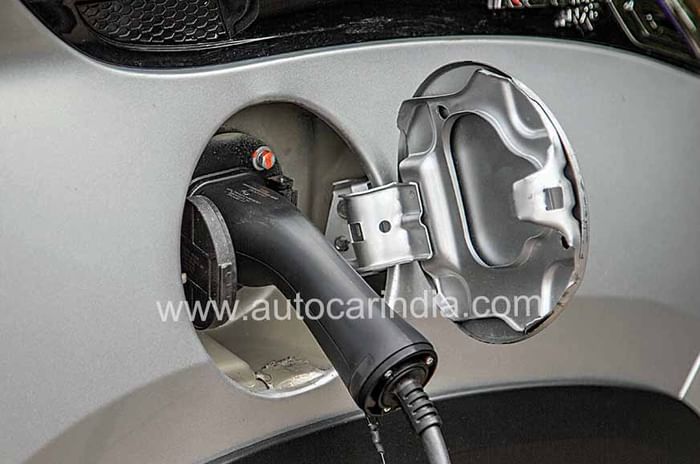Where will you be when the EV revolution hits? I’m paraphrasing here, but that, in essence, is what Ashish Tarte, head of product development at Mahindra Electric said to me. He likens it to when button-heavy Blackberries and Nokias, overnight, made way for smartphones; one minute they were there, the next they were gone. It’s the mantra the company exists upon – the idea that tomorrow, everyone could switch over to EVs, and you need to be prepared for that possibility. Let’s not forget, these are the guys that have pioneered EVs in India, all the way from the days of the Reva.
But even pioneers have to adapt sometimes; with new regulations around the corner and greater demands from a sceptical public reluctant to adopt EV tech, that’s exactly what Mahindra has done. The e2o and e2o Plus – the company’s electric hatchbacks – were axed on April 1 this year, as they didn’t and wouldn’t meet current and future safety norms. This eKUV100 is what will take over in their place.

First things first, however, this is not the final car, but a pre-production prototype. Yes, the final eKUV that goes on sale, likely in early 2020, will use essentially the same bodywork, but it will have lots of EV-specific exterior and interior add-ons to make it look different, like the ‘filler caps’ on each of the front fenders – one for regular charging, the other for fast charging. Also, because it’s a prototype, it comes with the caveat of being a work in progress and subject to change before production.
You should also know that this is not a powertrain swap-job from the current flagship model – the eVerito sedan, and instead uses all new components. The new motor makes 40kW (54.4hp) compared to the sedan’s 31kW, and 120Nm of torque versus 91Nm. And that torque has even more impact when you realise that at 1,200kg, the KUV’s motor has 65kg less to lug around. Its new battery can be charged in just 5hr 45min on a regular charger or 55min on a fast charger. Compare that to 11hr 30min and 90min, respectively, for the eVerito, and you really start to see the progress they’ve made with the new powertrain. The only downside appears to be that the battery is rated at 15.9kWh (versus 18.5kWh) and that the claimed maximum driving range has dropped by 20km to a 120km.

But the numbers only tell one side of the story. My short drive comprises a mix of tiny residential backlanes with patchy surfaces, followed by a brief blast on a small stretch of well-paved open road. The first impression is of a smoothness that just wasn’t there in earlier Mahindra EVs. You feel it most in the transition from acceleration to coasting regeneration to braking regeneration – these used to be three distinct steps, but now they flow like one constant, natural motion. I find myself hopping between the two pedals just to try it a few times.
The next is the torque. Pushing off from a standstill or low speeds finally gives you the kick in your lower back you expect from an EV, and it will hustle its way to about 60kph remarkably quickly. But before you mistake this for a Jaguar I-Pace, know that it soon runs out of pep, and acceleration tails off rapidly.

More interesting, however, is the improvements it makes on the ‘normal’ internal-combustion KUV100. They’ve obviously had to rework the suspension and the steering to compensate for the added weight (not much, about 60kg more than the diesel) and the positioning of the lithium-ion battery pack in a T-shaped tray under the floor. The result is a steering that, although still pretty lifeless and slow, does have a reassuring weight to it, this time. The suspension too feels a little bit more compliant, resulting in less body movement than the standard car. Other fun facts are that the handbrake has moved to its conventional location between the seats and none of the battery or electric components was allowed to eat into the cabin in any way, so you still get a flat floor at the rear.

As an internal combustion car, the KUV100’s sales have never been able to put a dent in the substantially populated mid-range hatchback segment. But as an EV, it’s something much greater. The price might go up, but the running costs are incredibly low, and it’s a far friendlier car to live with than the e2o it replaces. Plus, with learnings from its previous EVs applied to this new model, it’s clear, Mahindra is serious about its electric future. With this EV version, it feels like the KUV100 might have finally become the car it was always meant to be.
| Factfile | |
|---|---|
| Price | Rs 9-10 lakh (estimated) |
| Length | 3700mm |
| Width | 1735mm |
| Height | 1655mm |
| Wheelbase | 2385mm |
| Kerb weight | 1200kg |
| Power | 40kW at 3820rpm |
| Torque | 120Nm at 3000rpm |
| Battery type | Lithium-ion |
| Battery capacity | 15.9kWh |
| Range | 120km (claimed) |
| Charging time | 5hr 45min (regular) / 55min (fast charger) |
Click here for Mahindra models, prices, reviews, images, videos and more
Click here for Mahindra Electric models, prices, reviews, images, videos and more

































